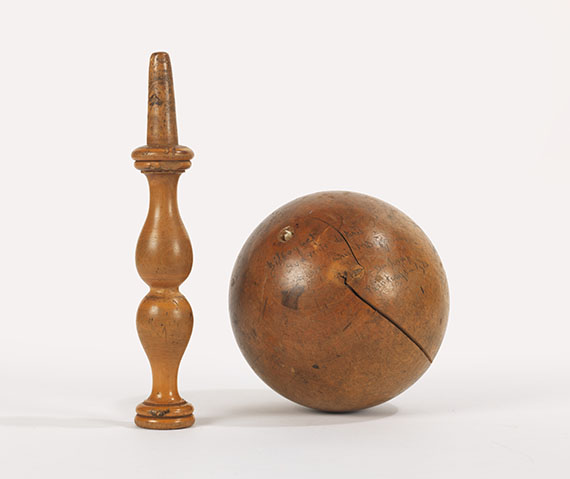Dictionary


Surrealism in Spain
André Breton had already referred to Spain as a "terre surréaliste", and indeed, Surrealism landed on fertile soil in Spain.
First and foremost, the two grandmasters of Spanish Surrealism have to be mentioned, Salvador Dalí (1904-89) and Joan Miró (1893-1983), who both come from Catalonia. Joan Miró went to Paris in 1919 and was one of the artist who signed André Breton's first "Surrealist Manifesto" in 1924. Together with Max Ernst, he developed ballet decorations and was also inspired by the art of Paul Klee. His pictures, permeated with jolly, at times scurrile and biomorph abstract forms, count among the most important expressions of a rather spontaneous and impulsive "Absolute Surrealism". Salvador Dalí, from the Catalan city Figueras, was introduced to the Paris Breton group by his fellow countryman in 1928. Two years later he began to develop the "paranoid-critical activity", a method that was supposed to bring about an expansion of consciousness, a state similar to insanity, which he wanted to employ for his art. The paranoiac's exaggerated sharp view onto his demonic image of the soul is mirrored in Salvador Dalí's verist Surrealism.
A rich surrealist tradition did not only form in Catalonia, but also in other Spanish regions. Salvador Dalí and his friends, the writer Federico García Lorca and the film maker Luis Buñuel worked in Madrid on the future trends of surrealist topics. In Aragonia, Alfonso Buñuel, Luis Buñuel's brother, just as some other artists, was inspired by the new techniques that had been introduced by Max Ernst.
Oscar Domínguez was from Tenerife where an international surrealist exhibition with works by e.g. André Breton and Benjamin Péret was organized as early as in 1935.
André Breton had already referred to Spain as a "terre surréaliste", and indeed, Surrealism landed on fertile soil in Spain.
First and foremost, the two grandmasters of Spanish Surrealism have to be mentioned, Salvador Dalí (1904-89) and Joan Miró (1893-1983), who both come from Catalonia. Joan Miró went to Paris in 1919 and was one of the artist who signed André Breton's first "Surrealist Manifesto" in 1924. Together with Max Ernst, he developed ballet decorations and was also inspired by the art of Paul Klee. His pictures, permeated with jolly, at times scurrile and biomorph abstract forms, count among the most important expressions of a rather spontaneous and impulsive "Absolute Surrealism". Salvador Dalí, from the Catalan city Figueras, was introduced to the Paris Breton group by his fellow countryman in 1928. Two years later he began to develop the "paranoid-critical activity", a method that was supposed to bring about an expansion of consciousness, a state similar to insanity, which he wanted to employ for his art. The paranoiac's exaggerated sharp view onto his demonic image of the soul is mirrored in Salvador Dalí's verist Surrealism.
A rich surrealist tradition did not only form in Catalonia, but also in other Spanish regions. Salvador Dalí and his friends, the writer Federico García Lorca and the film maker Luis Buñuel worked in Madrid on the future trends of surrealist topics. In Aragonia, Alfonso Buñuel, Luis Buñuel's brother, just as some other artists, was inspired by the new techniques that had been introduced by Max Ernst.
Oscar Domínguez was from Tenerife where an international surrealist exhibition with works by e.g. André Breton and Benjamin Péret was organized as early as in 1935.
Offers for Surrealism
Headquarters
Joseph-Wild-Str. 18
81829 Munich
Phone: +49 89 55 244-0
Fax: +49 89 55 244-177
info@kettererkunst.de
Louisa von Saucken / Undine Schleifer
Holstenwall 5
20355 Hamburg
Phone: +49 40 37 49 61-0
Fax: +49 40 37 49 61-66
infohamburg@kettererkunst.de
Dr. Simone Wiechers / Nane Schlage
Fasanenstr. 70
10719 Berlin
Phone: +49 30 88 67 53-63
Fax: +49 30 88 67 56-43
infoberlin@kettererkunst.de
Cordula Lichtenberg
Gertrudenstraße 24-28
50667 Cologne
Phone: +49 221 510 908-15
infokoeln@kettererkunst.de
Hessen
Rhineland-Palatinate
Miriam Heß
Phone: +49 62 21 58 80-038
Fax: +49 62 21 58 80-595
infoheidelberg@kettererkunst.de
We will inform you in time.




